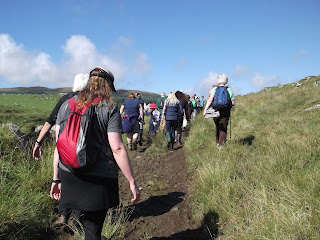
A keen band of 24 adventurous souls set about the long walk through the forestry with the guidance of Steve Mithen to the archaeological dig of the Neolithic burial tomb known on the OS map as the Giants Grave.
 |
| A nice rest after the climb |
In previous talks many of us had heard about the findings
from last year and this was an opportunity to see the dig in progress. The large megalith slabs of stone which make
up the remaining structure are impressive and to think were moved into position
by ancient peoples without the modern lifting devices of today. The painstaking work of the staff and
students removing the peat and soil debris of thousands of years to uncover the
clues of the ancient past and the ability to read these and surmise and predict
what went before is an impressive undertaking.


The views which once could be seen from the site and the
impressive nature that the original structure would have afforded on the
landscape is now obscured by a forest
of Sitka Spruce
 |
| Devil's Bit Scabious |
 |
| The Sickener (Russula emetic) |
Lichens and mosses have taken hold on the Megaliths too.
It is not until the decent out of the trees
and the view south across Laggan
Bay
Thank you to all those who came along and hope the footwear
dries out soon! 














































